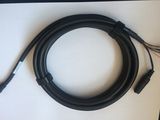Difference between revisions of "Albedo"
From 3D scanning Knowledge base - Photoneo wiki
(Created page with "Albedo or material reflectivity coefficient is the amount of light reflected (diffuse reflection). Some materials like snow reflect almost all light, thus the albedo is close...") |
|||
| Line 4: | Line 4: | ||
Some materials reflect very low light, such as black rubber. We still can see them, because our eyes are very well adapted to dynamic differences. Even when it reflects only a tenth of the light, it is still enough to see them well. | Some materials reflect very low light, such as black rubber. We still can see them, because our eyes are very well adapted to dynamic differences. Even when it reflects only a tenth of the light, it is still enough to see them well. | ||
| − | + | <gallery widths=300px> | |
| − | Black rubber cable on white paper sheet | + | File:Albedo.JPG|frame|alt=Black rubber cable on white paper sheet|Black rubber cable (albedo cca 0.1) on white paper sheet (albedo of 0.7) |
| − | + | </gallery> | |
| − | |||
As a curiosity, this [https://www.youtube.com/watch?v=Iyt47egkTu0 scientifically created "blackest" material] reflects no light and thus has albedo of zero. | As a curiosity, this [https://www.youtube.com/watch?v=Iyt47egkTu0 scientifically created "blackest" material] reflects no light and thus has albedo of zero. | ||
Latest revision as of 16:08, 25 August 2016
Albedo or material reflectivity coefficient is the amount of light reflected (diffuse reflection). Some materials like snow reflect almost all light, thus the albedo is close to 1 (meaning 100% of the light is reflected).
White paper reflects most of the light, but it is not so bright as snow -- it reflects about 70% of the light and thus the albedo is 0.7.
Some materials reflect very low light, such as black rubber. We still can see them, because our eyes are very well adapted to dynamic differences. Even when it reflects only a tenth of the light, it is still enough to see them well.
As a curiosity, this scientifically created "blackest" material reflects no light and thus has albedo of zero.
